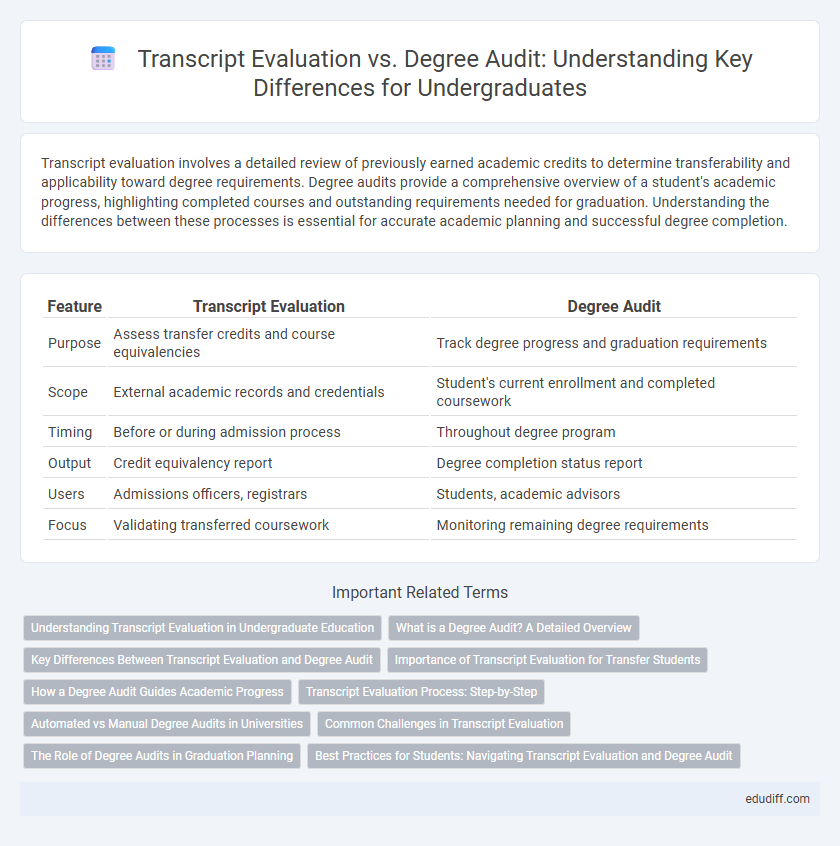Transcript evaluation involves a detailed review of previously earned academic credits to determine transferability and applicability toward degree requirements. Degree audits provide a comprehensive overview of a student's academic progress, highlighting completed courses and outstanding requirements needed for graduation. Understanding the differences between these processes is essential for accurate academic planning and successful degree completion.
Table of Comparison
| Feature | Transcript Evaluation | Degree Audit |
|---|---|---|
| Purpose | Assess transfer credits and course equivalencies | Track degree progress and graduation requirements |
| Scope | External academic records and credentials | Student's current enrollment and completed coursework |
| Timing | Before or during admission process | Throughout degree program |
| Output | Credit equivalency report | Degree completion status report |
| Users | Admissions officers, registrars | Students, academic advisors |
| Focus | Validating transferred coursework | Monitoring remaining degree requirements |
Understanding Transcript Evaluation in Undergraduate Education
Transcript evaluation in undergraduate education involves a detailed review of a student's academic records to verify course content, credit hours, and grades, ensuring proper transfer credits and degree progression. This process helps academic advisors and registrars determine course equivalencies and fulfill institutional requirements accurately. Unlike a degree audit, which tracks ongoing degree completion, transcript evaluation primarily focuses on validating prior academic work for credit recognition and placement.
What is a Degree Audit? A Detailed Overview
A degree audit is a comprehensive academic tool that tracks a student's progress toward meeting graduation requirements by comparing completed coursework with the institution's degree criteria. It provides a detailed overview of required courses, credit hours, and any outstanding academic obligations, ensuring students and advisors can efficiently plan the remaining semesters. Unlike transcript evaluation, which verifies transfer credits and prior academic records, a degree audit continuously monitors degree completion status throughout the undergraduate program.
Key Differences Between Transcript Evaluation and Degree Audit
Transcript evaluation reviews and verifies a student's prior academic records to determine course equivalency and credit transferability, primarily used during admission or transfer processes. Degree audit analyzes a current student's academic progress against degree requirements, tracking completed courses, GPA, and remaining credits needed for graduation. Key differences include their timing and purpose: transcript evaluation assesses external credits before enrollment, while degree audit monitors ongoing degree completion.
Importance of Transcript Evaluation for Transfer Students
Transcript evaluation plays a crucial role for transfer students by verifying the authenticity and relevance of previously earned credits to ensure accurate placement within the new institution's academic programs. This process facilitates the recognition of prior coursework, allowing transfer students to avoid redundant classes and accelerate their path to degree completion. Without a thorough transcript evaluation, students risk losing valuable credits, potentially extending their time and cost to graduate.
How a Degree Audit Guides Academic Progress
A degree audit systematically tracks an undergraduate's academic progress by mapping completed courses against program requirements, ensuring timely fulfillment of credit hours and prerequisites. It highlights outstanding coursework and identifies potential graduation bottlenecks, allowing students and advisors to make informed decisions on course selections and academic planning. Degree audits streamline academic advising by providing an up-to-date, comprehensive overview of a student's progress toward degree completion.
Transcript Evaluation Process: Step-by-Step
The transcript evaluation process involves systematically reviewing each course and grade from prior academic records to determine transfer credit eligibility. Evaluators compare course content, credit hours, and accreditation status with the current institution's curriculum requirements. This step-by-step analysis ensures accurate credit articulation and helps streamline degree progress for undergraduate students.
Automated vs Manual Degree Audits in Universities
Automated degree audits in universities leverage software to quickly analyze student transcripts against program requirements, reducing manual errors and saving administrative time. In contrast, manual degree audits require staff to interpret transcripts and degree criteria individually, often resulting in longer processing times and potential inconsistencies. The integration of automated systems with transcript evaluation enhances accuracy and provides real-time updates on student progress toward graduation.
Common Challenges in Transcript Evaluation
Transcript evaluation often faces challenges such as inconsistent course equivalencies across institutions, incomplete academic records, and varying grading scales that complicate credit transfer decisions. Evaluators must interpret diverse curricula and reconcile differences in course content, which can delay the assessment process. These issues frequently result in discrepancies that affect students' timely progression and accurate degree audits.
The Role of Degree Audits in Graduation Planning
Degree audits play a crucial role in graduation planning by providing an automated, comprehensive review of a student's academic progress toward degree completion, highlighting completed courses and outstanding requirements. Unlike transcript evaluations that primarily verify transfer credits, degree audits allow undergraduates to monitor real-time academic status, ensuring alignment with major-specific curriculum standards. This continuous tracking helps students and advisors identify potential course scheduling conflicts and prerequisite issues, streamlining the path to timely graduation.
Best Practices for Students: Navigating Transcript Evaluation and Degree Audit
Prioritize obtaining a clear understanding of your institution's transcript evaluation policies to ensure all external credits are accurately assessed and applied toward your degree requirements. Regularly review your degree audit reports to identify completed courses and outstanding requirements, enabling proactive academic planning and timely graduation. Engage with academic advisors to clarify discrepancies between transcript evaluations and degree audits, optimizing credit utilization and program progress.
Transcript Evaluation vs Degree Audit Infographic

 edudiff.com
edudiff.com